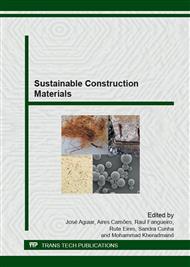p.300
p.307
p.321
p.329
p.339
p.351
p.357
p.367
p.379
Bamboo as Sustainable Material Used in Design and Civil Construction: Species, Management, Characterization and Applications
Abstract:
. The use of bamboo as construction and raw material for producing products can be considered a feasible alternative to the abusive use of steel, concrete and oil byproducts. Its use can also reduce the pressure on the use of wood from native and planted forests. Although there are thousands of bamboo species spread about the world and Brazil itself has hundreds of native species, the use and basic knowledge of its characteristics and applications are still little known and little disseminated. This paper's main objective is to introduce the species, the management phases, the physical and mechanical characteristics and the experiences in using bamboo in design and civil construction as per the Bamboo Project implemented at UNESP, Bauru campus since 1994. The results are divided into: a) Field activities - description of the technological species of interest, production chain flows, types of preservative treatments and clump management practices for the development, adaptation and production of different species of culms; b) Lab experiments - physical and mechanical characterization of culms processed as laminated strips and as composite material (glue laminated bamboo – glubam); c) Uses in projects - experiences with natural bamboo and glubam in design, architecture and civil construction projects. In the final remarks, the study aims to demonstrate, through practical and laboratory results, the material's multi-functionality and the feasibility in using bamboo as a sustainable material.
Info:
Periodical:
Pages:
339-350
Citation:
Online since:
December 2014
Keywords:
Price:
Сopyright:
© 2015 Trans Tech Publications Ltd. All Rights Reserved
Share:
Citation:


